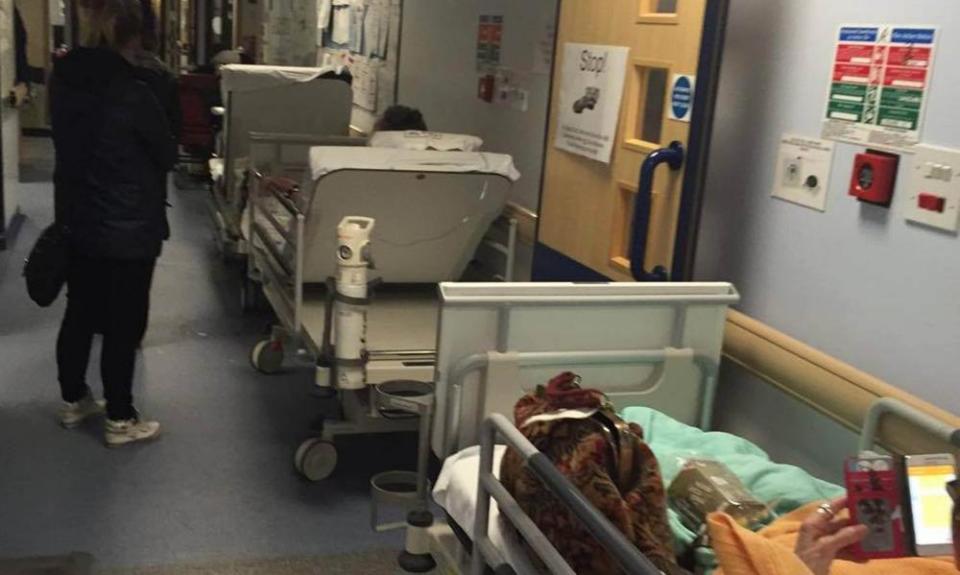Health services overloaded despite support pledges, claims report

Hospitals have been left dangerously overloaded because NHS bosses and ministers have failed to fulfil pledges to build up health services in or near people’s homes, a new report claims.
Patients are also losing out because a long-promised revolution in how NHS care is delivered to help them stay healthy at home and avoid unnecessary stays in hospital has not happened.
The warning, by the main organisation representing NHS trusts in England, also casts grave doubt on the progress of the Five Year Forward View, the government’s plan for improving the NHS.
Community services trusts, which specialise in providing out-of-hospital care, have been left “overstretched, underfunded and understaffed” because promises to expand their key role have not led to concrete action, claims NHS Providers.
Financial problems and serious understaffing mean they are struggling to cope with a surge in demand for their services linked to the ageing population and growth in long-term health conditions such as diabetes and high blood pressure. Declining numbers of district nurses and health visitors have coincided with more patients seeking care from community trusts.
“All too often NHS community services are marginalised, underfunded and short-staffed. It is patients who are paying the price for the failure to follow through on past commitments as hospitals struggle to keep up with rising demand for treatment”, said Chris Hopson, the chief executive of NHS Providers, which represents community and acute hospital trusts.
Governments and the NHS have been promising to boost out-of-hospital care since at least a 2003 report by Derek Wanless, commissioned by the Labour government. But the new report says 15 years on, provision remains worryingly inadequate.
A survey of 51 bosses of NHS community trusts included in it found that more than nine out of 10 feel the work their organisations do is not valued by NHS leaders nationally. Four out of five (82%) fear community services will not get the money they need to deliver the transformation in healthcare envisaged by the Five Year Forward View. In addition:
Half (52%) said funding in their area had fallen in the last year.
44% have been cutting costs.
Almost a third (30%) have shed staff.
Hopson added that the failure to build up community services matters because “it affects people who have to wait longer – often lonely, anxious and in pain – for the care they need at home. It causes delays for patients who could be discharged from hospitals if the right treatment or rehabilitation were available”.
“It can impact on our ability to stay well, avoiding sickness and the need for treatment. And it can make the difference over whether we are able to die in the manner and place of our choosing.”
Dr Nick Scriven, the president of the Society for Acute Medicine which represents hospital doctors, said: “The only thing preventing the total meltdown of our acute hospital services is community care in its broadest sense.
“Almost all the plans for how the NHS as a whole is meant to cope with demand both in short and longer terms as in the five year plan, are predisposed on increased care closer to home for patients, both preventing admissions to hospital and also providing timely care after the acute illness has passed.
The UK has fewer doctors and nurses than many other comparable countries both in Europe and worldwide. According to the Organisation for Economic Co-operation and Development (OECD), Britain comes 24th in a league table of 34 member countries in terms of the number of doctors per capita. Greece, Austria and Norway have the most; the three countries with the fewest are Turkey, Chile and Mexico. Jeremy Hunt, the health secretary, regularly points out that the NHS in England has more doctors and nurses than when the Conservatives came to power in 2010. That is true, although there are now fewer district nurses, mental health nurses and other types of health professionals.
NHS unions and health thinktanks point out that rises in NHS staff’s workloads have outstripped the increases in overall staff numbers. Hospital bosses say understaffing is now their number one problem, even ahead of lack of money and pressure to meet exacting NHS-wide performance targets. Hunt has recently acknowledged that, and Health Education England, the NHS’s staffing and training agency, last month published a workforce strategy intended to tackle the problem.
Read a full Q&A on the NHS winter crisis
“This report gives a much needed but frankly distressing wake-up call to all those who currently write the policies and tell us year on year things will be better, mainly because of better (ie more costly) community care projects.”
Labour MP Jonathan Ashworth, the shadow health secretary, said: “Eight years of austerity is seriously damaging the community health services we all rely on. At the very time when we should be investing more in community health provision, services are being restricted and vital staff like heath visitors and district nurses are falling. The next Labour government will expand, and invest in, community health services as the key to the long-term strength of the NHS.”
A spokesman for NHS England said: “This report highlights the inescapable pressure on GPs, hospitals and community services from a growing, ageing and sicker population, which will have to be properly factored in to NHS funding decisions for the decade ahead.”

 Yahoo News
Yahoo News 